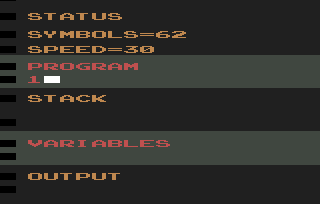Input is given through two Atari keypad controllers, which came with special overlays to show how to type the different commands and letters. [3] Programs are restricted to 64 characters in size and normally 9 lines of code, limiting the programs that can be written (users can disable all windows except Program and keep selecting "New Line" until 11 lines of code are present).
Language features
VCS BASIC supports the following keywords: [4]
- Statements:
Print - Structure:
Goto, If-Then-Else - Graphics:
Clear - Functions:
Hit, Key - Math:
+ - × ÷ Mod - Relational operators:
< > =
Unlike most BASIC implementations of the time:
- VCS BASIC uses ← instead of = for assignment; e.g.,
A←A+1. - Statements can be strung together on a line without a delimiter; e.g.,
Note←APrintA. - An
If statement can be used as a function, returning a value: Ver1←Ver1+IfVer1 Mod2Then8Else92 If statements can take an Else clause.
Special variable names:
Note sounds a musical note, assigned numbers from 0 to 7 - Numbers assigned to
Note are implicitly assigned modulus 8, thus 8 becomes 0, 9 becomes 1, etc.
Hor1, Hor2 - the horizontal coordinate of one of two squaresVer1, Ver2 - the vertical coordinate of one of two squares
The language supports 26 unsigned integer variables A to Z. VCS BASIC supports integers from 0 to 99. Math operations wrap, so 99+1 becomes 0, 99+2 becomes 1, etc.
Sample code
The following example of a Pong game is provided.
1 Hor2←2+Key 2 <syntaxhighlight lang="cbmbas" class="" style="border:none; padding: 0px 0px; color:var(--color-base, #202122); background:transparent; " inline="1">IfVer1>90ThenVer1←88</syntaxhighlight> 3 <syntaxhighlight lang="cbmbas" class="" style="border:none; padding: 0px 0px; color:var(--color-base, #202122); background:transparent; " inline="1">IfHit</syntaxhighlight><syntaxhighlight lang="cbmbas" class="" style="border:none; padding: 0px 0px; color:var(--color-base, #202122); background:transparent; " inline="1">ThenVer1←9</syntaxhighlight> 4 <syntaxhighlight lang="cbmbas" class="" style="border:none; padding: 0px 0px; color:var(--color-base, #202122); background:transparent; " inline="1">Ver1←Ver1+IfVer1</syntaxhighlight>[[Modulo operation|Mod]]2<syntaxhighlight lang="cbmbas" class="" style="border:none; padding: 0px 0px; color:var(--color-base, #202122); background:transparent; " inline="1">Then8</syntaxhighlight><syntaxhighlight lang="monkey" class="" style="border:none; padding: 0px 0px; color:var(--color-base, #202122); background:transparent; " inline="1">Else</syntaxhighlight>92 5 Hor1←Hor1+7 6 <syntaxhighlight lang="cbmbas" class="" style="border:none; padding: 0px 0px; color:var(--color-base, #202122); background:transparent; " inline="1">Goto1</syntaxhighlight>

